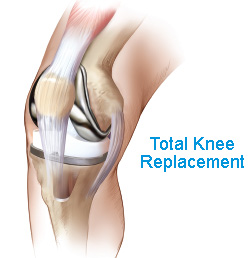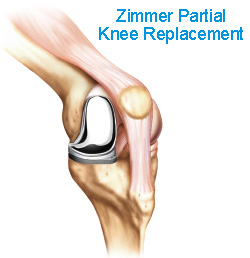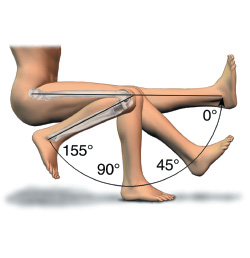
The surface of the thigh bone (femur) is replaced with a contoured metal component designed to fit the curve of your natural bone. The surface of the shin bone (tibia) is typically replaced with a flat metal component and a smooth plastic component that serves as cartilage. The undersurface of the kneecap may also be replaced with an implant made of plastic, or a combination of metal and plastic.
That’s a question you and your orthopedic surgeon will have to answer together. But when knee pain is so bad it actually interferes with the things you want or need to do, the time may be right. Here are some signs to consider:
- Medication and using a cane just aren’t delivering enough relief
- Pain is keeping you up at night
- Your knee aches during and after exercise
- Your knee stiffens up sitting in a car or a movie theater
- You are no longer as mobile as you’d like to be
What is total knee replacement?
It’s the same idea as having most things fixed—worn parts are taken out, and new parts are installed in their place. In total knee replacement surgery, the damaged portions of the knee bones are removed, and the knee is resurfaced with metal and plastic implants. A National Institutes of Health (NIH) Consensus Panel concluded that total knee replacement is extremely successful, resulting in “rapid and substantial improvement in the patient’s pain, functional status, and overall health-related quality of life in about 90% of patients.”4 Over 250,000 people a year undergo the procedure, in the US alone.
What is partial knee replacement?
Partial knee replacement is an option for the patient whose knee is damaged on one side and healthy on the other. The surgeon removes only the diseased portion of the knee before placing the implant, leaving the healthy portion untouched. As with any surgery, there are risks, and only a surgeon will be able to tell you if a partial knee is right for you.

Did you know? Sometimes, partial knee replacement can be performed with minimally invasive surgery. Hospital time is minimized, and the procedure may even be done on an outpatient basis. Talk with your surgeon to find out if you are a candidate for minimally invasive surgery.
How long does knee replacement last?
That’s a question no one can answer for sure. The patient’s physical condition, activity level, and weight all play a role. With appropriate activity, knee replacements can last many years. Your individual outcome depends on many factors that you can discuss with your surgeon.
What risks are involved?
Every surgical procedure has some risks and benefits. Your individual results will depend on your personal circumstances, and recovery takes time. Infection is a risk in any surgical procedure, and according to the American Academy of Orthopaedic Surgeons, 1.8% of patients get an infection in the first 2 years. When infection occurs after total knee replacement, it is most commonly caused by bacteria that enter the bloodstream during dental procedures or from urinary tract, skin, or fingernail infections. Although uncommon, when these complications occur, they can delay full recovery. For the first 2 years after your knee replacement, you must take preventive antibiotics before dental or surgical procedures that could allow bacteria to enter your bloodstream. After 2 years, talk to your orthopedist and your dentist to see if you still need preventive antibiotics before other procedures.
Dislocation can result from improper positioning during surgery. Joint fracture has been reported following joint replacement and is typically caused by heavy weight or people with unrealistic performance expectations. How long a knee replacement will last varies from person to person. It depends on many factors, such as your physical condition and activity level, body weight, and the surgical technique.
1) The Zimmer Gender Knee has a thinner profile than traditional knee replacements
2) It allows for more natural movement of the kneecap
3) It has a shape specially contoured for women
Blood clots in the leg veins are the most common complication of knee replacement surgery. Your surgeon will outline a prevention program. This may include periodic elevation of your legs, lower leg exercises to increase circulation, support stockings, and medication to thin your blood.
How do I know which knee is right for me?
Knee replacements have been highly successful for more than 30 years. According to the National Institutes of Health, 9 out of 10 patients who undergo the procedure report improved pain relief, knee function, and overall health-related quality of life. It is important to be involved in your recovery, and there are some additional things about knee replacement you may wish to discuss with your primary doctor and an orthopedic surgeon:
Be flexible

Flexion, or bending, is an important subject when talking with your doctor about which knee replacement is right for you. Many everyday activities require good range of knee motion, such as climbing stairs (75-140 degrees) and sitting in a chair (90-130 degrees). Other activities, such as gardening, golfing, kneeling, or sitting cross-legged, can demand an even greater degree of bending. Zimmer was the first to develop several high-flex knee implants, including NexGen® and Gender Solutions Knees, which accommodate 155 degrees of deep-knee bending in patients who are able. Most other knee replacements accommodate knee bending only up to 125 degrees. Talk to your doctor about the risks that are associated with knee replacement.
Minimally Invasive Options
Traditional knee replacement surgery involves a long incision (8 to 12 inches) and a lengthy rehabilitation. Over the past decade, however, minimally invasive techniques have been developed to place the very same clinically proven joints. Today, there are even minimally invasive procedures for partial knee replacement. You and your surgeon can determine if you are a candidate for minimally invasive surgery.
Zimmer MIS Knee Replacement
Zimmer’s minimally invasive knee replacement techniques involve less cutting of skin than traditional surgery, and less or no cutting of key muscles and tissues. The goals of the Zimmer MIS techniques are to alleviate pain, restore mobility, and get you back to your everyday activities sooner.
Zimmer MIS procedures are named based on how your surgeon accesses your knee, so that the damaged areas can be replaced with new parts. You may hear your doctor talk about these techniques. The most commonly used Zimmer minimally invasive and “mini-incision” total knee replacement techniques are called:
- MIS Quad-Sparing™ Total Knee Arthoplasty
- MIS Subvastus
- MIS Midvastus
- MIS Medial Parapatellar
